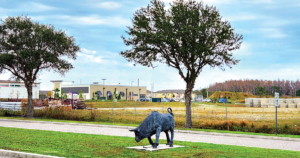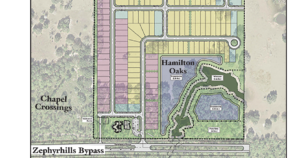
Although traffic and congestion are part of daily life for those driving around Wesley Chapel and New Tampa, getting out of the area is only the beginning of what can be a long and teeth-gnashing chore for area commuters.
For folks heading to work in Tampa or St. Petersburg, once the Bruce B. Downs (BBD) Blvd./S.R. 56/S.R. 54 maze is completed, it’s onto the local interstates, which offer their own headaches.
But, there are efforts now ongoing to change that.
David Gwynn, the Florida Department of Transportation (FDOT) District 7 secretary of transportation, who spoke at the June 2 North Tampa Bay Chamber of Commerce breakfast at Pasco Hernando State College’s Porter Campus at Wiregrass Ranch, provided some promising updates about a host of road improvements FDOT currently is working on or has planned that will have an effect on traffic faced by Wesley Chapel drivers.
“We’ve got some big projects going on,” Gwynn said, adding that one of the biggest challenges at the moment is finding enough contractors to do all the work at reasonable prices, due to a bustling economy.
“We’re probably taxing the construction industry,” he said. “That’s probably the thing we worry about the most.”
Locally, Gwynn said the roadwork that will impact travel around Wesley Chapel is the work on east-west roads like S.R. 56 (which is being extended), S.R. 54 (which is being widened) and S.R. 52 (which is being extended).
“There’s a lot of demand to go east-west,” Gwynn told the Chamber members. “Right now, getting from US 301 to I-75 isn’t that easy. These will provide new corridors to connect it and will probably provide the biggest benefit of all.”
Gwynn also said that the diverging diamond interchange (DDI) at the S.R. 56 exit of I-75 and the planned (and finally funded) Overpass Rd. interchange between the S.R. 54 and S.R. 52 exits will ease traffic immeasurably.
Outside Of The Area, But…
Notably for local commuters heading to work, improvements are coming to two major Tampa trouble spots — the north- and southbound exit lanes at I-4 and I-75 and the stretch of I-275 from Bearss Ave. to the 275/I-4 interchange, better known as “malfunction junction.”
While the I-75 project is well under way — in fact, the northbound ramp from I-4 to I-75 already has been completed — the enhancements on I-275 are still only in the planning stages, but cleared a major hurdle on June 11, when, after a five-hour debate, the Hillsborough County Metropolitan Planning Organization (MPO) voted 11-5 to keep the project in its 5-year transportation plan.

The leading proposal to fix the congestion problem is to transform I-275 from three lanes in each direction between Bearss Ave. (and the interchange at I-4) to four lanes while “hardening” the shoulder for emergency vehicles and buses. The project also would include enhancements at malfunction junction.
The I-275 proposal continues to draw strong opposition from many Seminole Heights and Ybor City residents, who favor a no-build alternative and an emphasis on mass transit solutions.
However, the Tampa Bay Partnership, a privately-funded business-driven advocacy group dedicated to solving Tampa Bay’s most pressing challenges, commissioned a survey in mid-May of 400 Hillsborough County residents, and the results showed that 84 percent (with a reported margin of error of only 5 percent) of those surveyed were in favor of widening I-275.
Traffic congestion (43 percent) and meeting the future growth needs of the area (34 percent) were the primary reasons given for the support.
And, while opponents prefer a number of different transit options, the Tampa Bay Partnership survey showed that 79 percent of those polled believe that a balance of transit and interstate improvement options is the best way to create a better transportation system.
The I-275 project already has $80-million allocated for it, and that money would have been lost if the vote had gone the other way. Funding still needs to be secured for the full cost of the project, which is $400 million total, before it can proceed.
Pasco’s Board of County Commissioners wrote a letter, signed by all five commissioners, to Hillsborough MPO chairman Les Miller voicing support prior to the vote, stating that, “Adding these general use lanes is an important priority to help the flow of people and commerce throughout our region.”
The letter from the Pasco BOC also stated that not moving forward with the I-275 plan would hurt the proposed Bus Rapid Transit project that would connect Wesley Chapel to Tampa and St. Petersburg.
Both the I-275 and I-75 projects could substantially improve drive times for Wesley Chapel and New Tampa residents who work in south Tampa or even St. Pete — or for anyone trying to get to Tampa International Airport.
The biggest current FDOT project, by far, is replacing the existing Howard Frankland Bridge, which alone will cost $800 million. For those who work in St. Petersburg, the drive back to Pasco takes more than an hour at rush hour, and a lot of that time is often spent in that seemingly-never-moving traffic on that bridge.
Another project that would speed the commute along I-275 is one being proposed to fix the Westshore Blvd. interchange, which Gwynn says is FDOT’s No. 1 unfunded priority. A public workshop was recently held, with a public hearing scheduled for January of 2020.

The I-75 southbound interchange improvement at I-4 (see picture, top right) is well under way and will help relieve a bottleneck all too familiar to Wesley Chapel and New Tampa residents who make the drive to Tampa or Orlando.
The project is relocating the exit point to I-4 roughly one mile to the north, which will create a 1.25-mile-long, two-lane ramp separated from the mainline travel lanes by a guardrail. The new two-lane ramp will split at the current ramp location, with lanes going east and west onto I-4.
Drivers will no longer be able to dive into the current exit lane off southbound I-75 onto I-4 at the last second, eliminating that decision point.
Work on the northbound entrance to I-75 was completed last year, joining the two ramps into one two-lane ramp that is separated from the mainline travel lanes until merging into a single lane and entering I-75 on a new, long auxiliary lane, according to the FDOT website. That project cost $18.4 million.
“To be honest, there is never enough money to solve all the issues out there, so we try to hit the critical ones first,” Gwynn told the Chamber members at the breakfast. “We’re never going to catch up or make it congestion-free, but we try to do our best to provide enough corridors that hopefully it won’t be horrible.”




No comment yet, add your voice below!